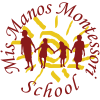Thoughts on the Montessori Method by Dr. Celeste Miller, retired early childhood professor with Montessori experience, and proud grandmother of former Mis Manos graduates, Elena and Alexander. Learning to write numbers and letters is a physically demanding task for children as well as a cognitive one. Often, when children begin to actually write out words and numbers, their hands tire and it is not necessarily an easy or fun task. For some children, writing becomes something to avoid due to the physical discomforts. An understanding of the need to gradually prepare the hand for writing was a foresight of Maria Montessori and so she deliberately created any number of opportunities for a child to manipulate objects in ways that would strengthen and flex the fingers and hands. These activities that strengthen the wrist and fingers help to prepare the child to write with less physical strain.
Besides having a direct instructional purpose, Montessori materials often have an indirect purpose as well. Take for example the tracing of the geometric shapes. You’ll see a square paper with a tracing of a geometric shape on it starting to come home with your child at some point. Learning the names and internalizing aspects of the geometric shape is the direct purpose of this activity, but an indirect purpose is the preparation of the hand for writing. This activity of tracing strengthens the fingers and hand many months and even years before the child will write words and sentences. Building the “pink tower” and arranging the “brown stairs” requires the child to carry heavy blocks for some distance, likewise strengthening the arms and hands. These are two other examples of Montessori materials with an indirect purpose of preparing the body to write. The teachers could point out many more to you.
You can think like Maria Montessori and examine the types of activities your child is doing in your home that might also contribute to strengthening fingers and hands. Generally speaking, handling objects with a little extra weight are helpful as are activities that turn the wrists. Kneading dough (not that many of us bake our own bread anymore) is an example of a useful activity. Sewing cards would be another example. Toys that require pushing one button over and over probably aren’t that helpful.
Because writing usually precedes reading in a developmental process, if writing is fun and easy to do because the hand is strengthened and ready, then reading has a better emotional foreshadowing as well. Food for thought. I find the Montessori approach is all so logical and so profound. And could there be a better name to call this school than Mis Manos!!
Dr. Celeste Miller
